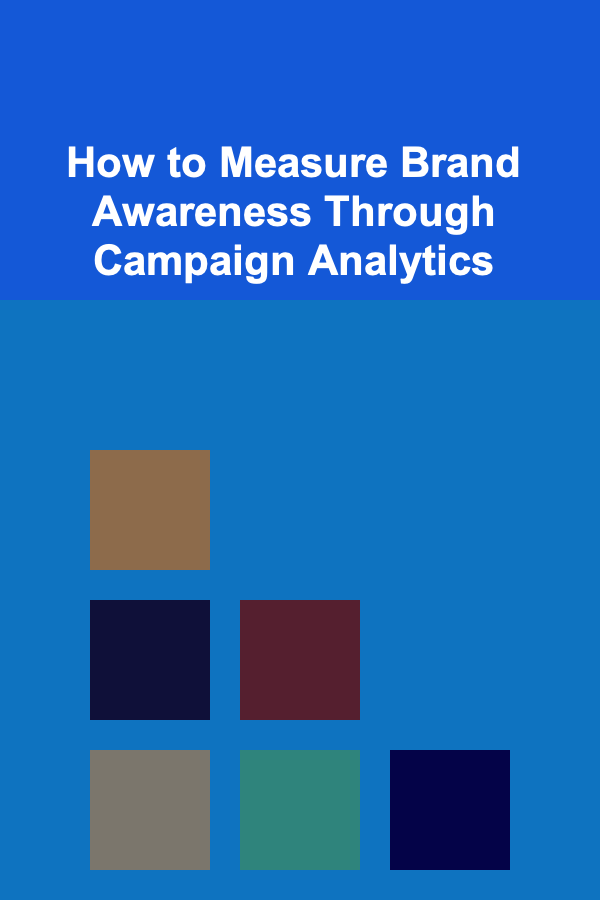
How to Measure Brand Awareness Through Campaign Analytics
ebook include PDF & Audio bundle (Micro Guide)
$12.99$7.99
Limited Time Offer! Order within the next:

Brand awareness is one of the most crucial aspects of building a successful brand. It serves as the foundation for customer loyalty, trust, and long-term engagement. Without effective brand awareness, your marketing efforts might not reach the right audience or translate into meaningful business results. Fortunately, with the advancements in digital marketing, measuring brand awareness is no longer a vague concept but an actionable and data-driven process.
In this article, we will explore how to measure brand awareness through campaign analytics. We'll dive into the key metrics, tools, and methods you can use to evaluate the effectiveness of your marketing campaigns and track how well your brand is resonating with your target audience.
Understanding Brand Awareness
Before diving into analytics, it's essential to have a clear understanding of what brand awareness is. At its core, brand awareness is the degree to which consumers can recognize or recall your brand. It's the first step in the customer journey, as consumers need to be aware of your brand before they can consider, purchase, or advocate for your products or services.
Brand awareness can be broken down into two primary types:
- Unaided Awareness (Spontaneous Recall): This is when a consumer can recall your brand without any prompt. For example, if you ask a person to name soft drink brands, and they mention Coca-Cola without any cue, that's unaided brand awareness.
- Aided Awareness (Prompted Recall): This is when consumers recognize your brand when provided with some sort of prompt, such as a logo or a list of options.
Campaign analytics help measure both types of awareness through different metrics and data points.
Key Metrics to Measure Brand Awareness
Measuring brand awareness is not about tracking direct sales or conversions; rather, it focuses on understanding how well your brand is being recognized by your audience. Here are some of the key metrics you can use to measure brand awareness:
2.1 Reach and Impressions
- Reach refers to the number of unique people who have been exposed to your campaign, whether through social media, online ads, or content marketing.
- Impressions are the total number of times your content was displayed, regardless of whether it was clicked or not.
These two metrics give you an initial idea of how far your brand is spreading across your target audience. The greater the reach and impressions, the higher the potential for increasing brand awareness. These metrics are particularly valuable when evaluating social media campaigns, digital ads, and influencer collaborations.
2.2 Social Media Mentions and Engagement
Tracking social media mentions is one of the most straightforward ways to measure brand awareness. Analytics platforms like Hootsuite , Sprout Social , and Brandwatch can track how often your brand is mentioned across social media platforms and blogs. These mentions can be positive, neutral, or negative, and you can track sentiment over time.
Engagement metrics are another valuable tool. This includes:
- Likes, shares, comments, and retweets: These interactions show that people are engaging with your brand and, in turn, spreading awareness to their networks.
- Hashtag tracking: Creating a branded hashtag and tracking its use helps you see how much your brand is being discussed or shared on social platforms.
Social media listening tools like Mention and BuzzSumo can help you track both branded and unbranded mentions across various digital channels, providing insight into how frequently your brand is talked about in the wider digital ecosystem.
2.3 Website Traffic
An increase in website traffic is often a clear sign that your brand awareness efforts are working. Tools like Google Analytics provide detailed insights into the sources of traffic to your website, allowing you to determine how visitors are discovering your brand.
Look at:
- Direct traffic: People who type your brand's URL directly into their browser.
- Referral traffic: Visitors who come to your website from other sites, such as blogs, social media, or news articles.
- Organic search traffic: Visitors who find your website through search engines after searching for terms related to your brand.
An uptick in traffic, particularly from organic search, suggests that your brand is becoming more recognizable in search engines, a key indicator of growing awareness.
2.4 Surveys and Polls
Direct feedback from your audience can offer valuable insights into brand awareness. Conducting brand awareness surveys and polls helps you gauge whether your target audience knows about your brand and how familiar they are with it.
Survey questions might include:
- "Have you heard of [brand name]?"
- "Can you recall any recent advertisements or campaigns by [brand name]?"
- "How likely are you to recommend [brand name] to others?"
This can be done through online surveys via platforms like SurveyMonkey , Google Forms, or even social media polls.
Surveying both existing customers and new or potential customers helps to differentiate between brand awareness among your loyal audience and the broader market.
2.5 Brand Search Volume
The volume of searches for your brand on search engines like Google is another key indicator of brand awareness. If more people are searching for your brand, it means that awareness of your brand is growing, and consumers are actively trying to learn more about you.
Google Trends can help you track search volume over time, providing insights into whether your brand is experiencing increased interest after a particular campaign or marketing initiative.
Tools for Measuring Brand Awareness
The right tools can streamline the process of collecting and analyzing brand awareness data. Here are some of the most popular tools used for campaign analytics:
3.1 Google Analytics
Google Analytics is a comprehensive tool for tracking website performance and user behavior. You can measure website traffic, referral sources, and user demographics. Additionally, Google Analytics helps you understand how effective your content is at driving brand awareness by tracking metrics like page views, average session duration, and bounce rate.
3.2 Social Media Analytics Tools
To track social media brand awareness, tools like Sprout Social , Hootsuite Analytics , and BuzzSumo offer in-depth analytics. These platforms allow you to monitor brand mentions, engagement, reach, and sentiment across various social media platforms.
3.3 Brand Monitoring Tools
Brand monitoring tools like Brandwatch , Mention , and Talkwalker allow you to track online conversations surrounding your brand. These tools provide insights into how frequently your brand is being mentioned, where the conversations are happening, and what the sentiment is.
3.4 Survey Platforms
As previously mentioned, platforms like SurveyMonkey and Google Forms are essential for collecting direct feedback from your audience. You can create custom surveys that target specific groups, helping you to measure brand awareness from different perspectives.
Evaluating Brand Awareness Across Campaigns
Once you have gathered your data from the above metrics and tools, it's important to evaluate the effectiveness of your campaigns. Here's how you can assess the results:
4.1 Compare Metrics Over Time
The key to measuring brand awareness is observing trends over time. Are your reach, impressions, and social media mentions increasing after each campaign? If yes, then your brand awareness is growing. Conversely, a plateau or decline in these metrics may indicate that your efforts aren't resonating with your target audience or that adjustments need to be made.
4.2 Measure Campaign-Specific Goals
Each campaign should have specific objectives tied to brand awareness. Whether you're launching a new product, conducting a social media campaign, or sponsoring an event, measure the campaign's impact on awareness by comparing pre- and post-campaign metrics.
For example, if you launched a new campaign using a unique hashtag, monitor how many times that hashtag was used before and after the campaign.
4.3 Assess Audience Engagement and Sentiment
Evaluate the quality of your brand mentions and engagement. Not all brand mentions are created equal. Positive sentiment is an indicator of successful brand awareness, while negative sentiment may signal that your message is not being received as intended.
Use sentiment analysis tools to track how people are feeling about your brand and adjust your campaigns accordingly.
Conclusion
Measuring brand awareness through campaign analytics is an ongoing process that requires consistent monitoring and evaluation. By utilizing a combination of key metrics, tools, and strategies, you can gain valuable insights into how your audience perceives your brand and how effective your marketing campaigns are in increasing awareness.
Ultimately, understanding brand awareness through analytics allows you to refine your marketing strategies, optimize campaigns, and create more targeted initiatives that build stronger connections with your audience. With the right approach, analytics can not only measure your brand awareness but also drive growth and long-term success.
Other Products

Beginner Guide: The Guide to Stress Management
Read More
How to Incorporate Sustainable Holiday Decorations Into Your Home
Read More
How to Invest in Bonds and Understand Their Risks
Read More
How to Plan Fun Family Game Nights at Home
Read More
How to Renovate Your Home for a More Open and Airy Feel
Read More